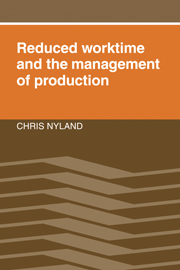5 - The internationalisation of rationalised worktimes
Published online by Cambridge University Press: 25 March 2010
Summary
The technical and philosophical approach to management pioneered by Taylor initially attracted interest outside the United States during the last years of the nineteenth century. At first this interest was decidedly muted. In time, however, Taylor's basic methodology became the cornerstone for modern management practice around the globe. This is true of all industrialised nations including those in which ownership of the means of production is socialised. In the years after 1920 the employers of all nations viewed with a mixture of fear and awe the growing industrial power of the U.S.A. Many soon came to realise that they had little choice but to follow the path pioneered by the Americans. This realisation was to accelerate radically the global diffusion of scientific management. In this expansion many of the American movement's concrete or specific aspects were severely modified. Its system, philosophy and method, however, were largely transported undisturbed.
As in the United States, the global application of Taylorism soon moved beyond the resolution of technical problems associated with the workshop. In the early 1920s it merged with industrial psychology, with the result that the rationalisers came to place even greater emphasis on the human factor. At the same time its advocates expanded their horizons to the national and even to the international level as they applied Taylor's planning methods on an increasingly wider scale to such problems as standardisation, marketing, industrial concentration and the systemisation of both private and public bureaucracies. In Europe these developments, by the end of the decade, led many to ask how a “common market” could be organised which would enable European producers to attain the economies of scale Taylorism had made possible.
- Type
- Chapter
- Information
- Reduced Worktime and the Management of Production , pp. 156 - 193Publisher: Cambridge University PressPrint publication year: 1989



